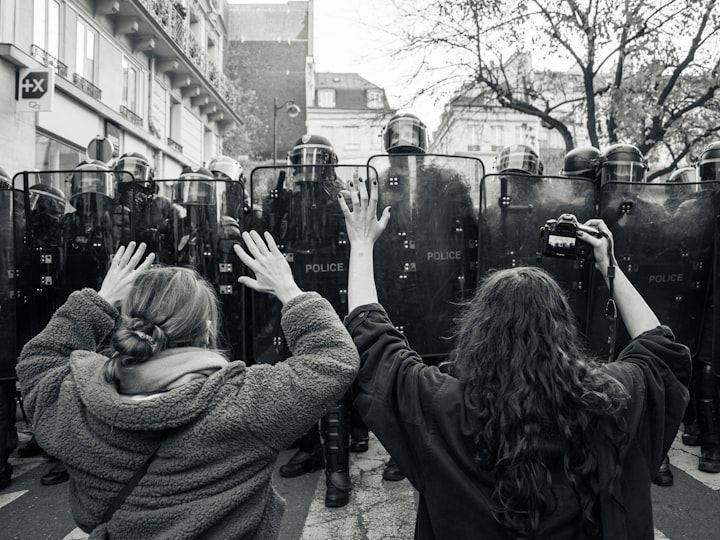Violet Jessop, the Titanic Passenger Who Cheated Death Four Times
Unlucky or lucky, you decide?

In the 1900s, travelling by sea was hugely popular. Then, the waters were as congested as the skies are today. One company producing liners for these travels was the White Star Line.
White Star had three important ships over its years of operating. The first was the RMS Olympic, the second the infamous RMS Titanic and the last HMHS Britannic. Violet Jessop travelled on all three.
Known as the unsinkable lady, she not only travelled on all three, she was working on each when they were hit. She was aboard the Titanic and Britannic when they sank to the ocean floor.
Whether she was the luckiest lady on board or the unluckiest is a matter of perspective.
The Early Life of Violet Jessop

Violet Constance Jessop was born on 2nd October 1887 in Argentina to parents William and Katherine Jessop. The family were Irish immigrants; William was a sheep farmer. The family of two adults and six children lived in a one-room cottage. Violet was the eldest.
The young Violet became ill with tuberculosis; her parents were told she had a couple of months to live. But, in a move she became known throughout her life for, the young Violet pushed the grim reaper away and recovered completely.
Tragedy struck the family when Violet was sixteen; her father passed away. Left with little money, her mother moved the family back to the UK.
Here Katherine took a job as a ship stewardess whilst Violet looked after the other children. Violet also enjoyed studying at a convent school, where she was a good student.
When her mother became ill, Violet quit school to support her family. In 1908, like her mother, she went for a job working as a stewardess on the Royal Mail Line. The job was usually for older women and there was concern about her age of only twenty-one. Violet informed the owner it would not be a problem; she would dress older.
RMS Olympic

In 1911, Violet took a job on the largest ship at the time, RMS Olympic. She had already worked for White Star for a year aboard The Majestic. Violet loved the Olympic; despite working seventeen-hour days, she commented how happy she was. She worked on the ship for a year before the rumour of a new vessel started.
On 20th September 1911, Olympic was leaving the harbour. It had been running for a while parallel to the warship, HMS Hawke. Unfortunately, once out at sea, the two ships struck each other. Hawke ripped two large holes in the side of Olympic; it had to return to port.
Although no one was hurt in the accident, it is doubtful the ship would have made its way back, without incident, had it not been so close to the port.
This was when the other staff on Olympic started to persuade her to apply for another job. Reluctant at first, Violet relented and applied for the job as a stewardess on Titanic.
RMS Titanic

Violet, in her memoirs, states her first impression of Titanic, the splendour and riches she observed.
It was her job to take care of the female first-class passengers, some of whom she was not so impressed. With some rooms costing as much as $50000 in today's times, it is not surprising that Titanic had to be spectacular.
On the 14th April 1912, Violet had just returned to her cabin after a long day. She had said her prayers and was dozing off when she heard a crash and the engines stopped. She then said she heard many voices, people talking outside her room which was previously quiet and stewards returning to work early.
Violet was asked to guide the women and children to the lifeboats. She mentions how distraught she was seeing many lifeboats lowered only half full. There was a general feeling that the Titanic would not sink, so why would you want to get into a freezing lifeboat?
Finally, Violet was placed into lifeboat sixteen. As it was being lowered, one steward handed her a baby. The baby had been put on the deck; Violet was to take care of it. She sat nursing the infant for eight hours while watching the Titanic sink. She talks about the horror of hearing thousands of voices cry out as the ship sunk.
I was still clutching the baby against my hard cork lifebelt I was wearing when a woman leaping at me and grabbed the baby, and rushed off with it, it appeared that she put it down on the deck of the Titanic while she went off to fetch something, and when she came back the baby had gone. I was too frozen and numb to think it strange that this woman had not stopped to say 'thank you'. - Violet Jessop aboard the Carpathia
HMHS Britannic

Many would have been put off life at sea after surviving the tragedy on the Titanic, but not Violet. In 1916, as World War I raged, the Britannic was converted into a floating hospital for evacuated soldiers. Violet volunteered as a nurse with the British Red Cross.
The Britannic was considered the safest of the three ships. Learning from previous mistakes, White Star had ensured that the Britannic had more lifeboats than passengers. On 21st November, the Britannic was sailing in the Aegean Sea when it was hit.
It is unclear what hit the Britannic, whether it hit a mine or a torpedo, but the alarms were sounded; everyone evacuated, the ship was sinking. The crew and patients were loaded into the lifeboats when it became clear that the Britannic was sinking much faster, than the Titanic had.
When the propeller came out of the water, it started to drag the boats towards it. Violet was left with no choice but to jump out of the lifeboat. It was turned into matchsticks by the huge propeller. She hit her head on the boat's keel as she jumped, again escaping the reaper.
I leapt into the water but was sucked under the ship's keel which struck my head. I escaped, but years later when I went to my doctor because of a lot of headaches, he discovered I had once sustained a fracture of the skull! - Violet Jessop
Life after White Star
On 29th October 1923, Violet married John James Lewis the marriage was short-lived; she bore no children.
Many would presume that Violet gave up working on ships at this point, but this was not so. Single again, Violet went back to her first love, the sea. This time she worked for Red Star on around-the-world cruises.
Violet would continue to work on ships as a stewardess for forty years. Finally, at sixty-one, she retired to a cottage in the English countryside, decorating it with trinkets she had found from many countries.
In her memoirs, she talks about one rainy night when she received a phone call. The voice on the phone asked if she had rescued a baby from Titanic; the voice then identified themselves as the baby and hung up. Although a friend reasoned that this was a prank by locals, Violet stated she had told no one of the baby before recounting the story then.
The grim reaper finally secured Violet in 1971, when she died of congestive heart failure at age eighty-nine. Miss unsinkable, who survived tuberculosis and three boat crashes, is one of the most famous Titanic survivors. She loved her job so much that she didn't let two near-death experiences deter her.

If you enjoyed this article, please subscribe to my writing, share it and give it a heart. As a writer tips and pledges mean a great deal to me, so a massive thank you if you send one.
About the Creator
Sam H Arnold
Writing stories to help, inspire and shock. For all my current writing projects click here - https://linktr.ee/samharnold
Reader insights
Outstanding
Excellent work. Looking forward to reading more!
Top insights
Easy to read and follow
Well-structured & engaging content
Excellent storytelling
Original narrative & well developed characters
Expert insights and opinions
Arguments were carefully researched and presented
Eye opening
Niche topic & fresh perspectives
Heartfelt and relatable
The story invoked strong personal emotions
Masterful proofreading
Zero grammar & spelling mistakes
Compelling and original writing
Creative use of language & vocab
On-point and relevant
Writing reflected the title & theme






Comments (1)
Amazing woman and experiences to last several lifetimes!